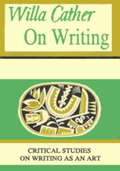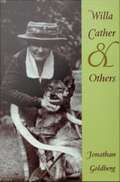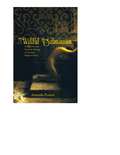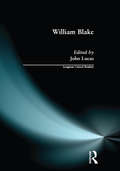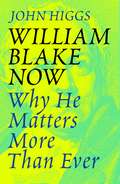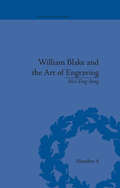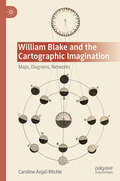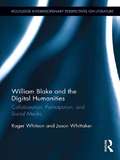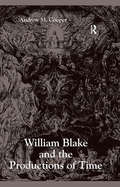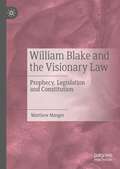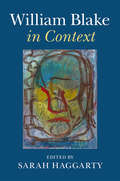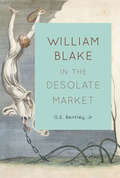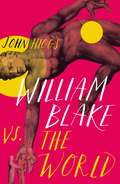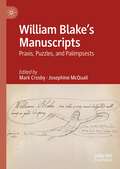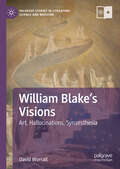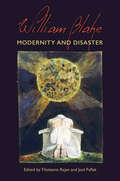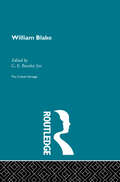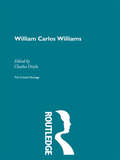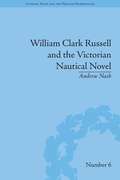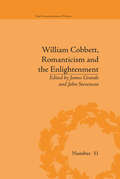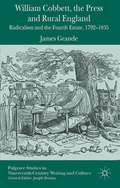- Table View
- List View
Willa Cather On Writing: Critical Studies on Writing as an Art
by Willa Cather"Whatever is felt upon the page without being specifically named there--that, one might say, is created." This famous observation appears in Willa Cather on Writing, a collection of essays and letters first published in 1949. In the course of it Cather writes, with grace and piercing clarity, about her own fiction and that of Sarah Orne Jewett, Stephen Crane, and Katherine Mansfield, among others. She concludes, "Art is a concrete and personal and rather childish thing after all--no matter what people do to graft it into science and make it sociological and psychological; it is no good at all unless it is let alone to be itself--a game of make-believe, of re-production, very exciting and delightful to people who have an ear for it or an eye for it."
Willa Cather and Others
by Jonathan GoldbergAfter many years as one of the premier scholars of English Renaissance literature, Jonathan Goldberg turns his attention to the work of American novelist Willa Cather. With a focus on Cather's artistic principle of "the thing not named," Willa Cather and Others illuminates the contradictions and complexities inherent in notions of identity and shows how her fiction transforms the very categories--regarding gender, sexuality, race, and class--around which most recent Cather scholarship has focused. The "others" referred to in the title are women, for the most part Cather's contemporaries, whose artistic projects allow for points of comparison with Cather. They include the Wagnerian diva Olive Fremstad, renowned for her category-defying voice; Blair Niles, an ethnographer and novelist of jazz-age Harlem and the prisons of New Guinea; Laura Gilpin, photographer of the American Southwest; and Pat Barker, whose Regeneration trilogy places World War I writers--and questions of sexuality and gender--at its center. In the process of studying these women and their work, Goldberg forms innovative new insights into a wide range of Cather's celebrated works, from O Pioneers! and My ntonia to her later books The Song of the Lark, One of Ours, The Professor's House, Death Comes for the Archbishop, and Sapphira and the Slave Girl. By applying his unique talent to the study of Cather's literary genius, Jonathan Goldberg makes a significant and new contribution to the study of American literature and queer studies.
Willa Cather: A Critical Biography
by Leon Edel E. K. BrownE.K. Brown wrote an appreciation of Cather's work which was presented on the occasion of her 70th birthday. Cather was so enamored with it that after some friendly correspondence with Brown, it was agreed that after her death, he would embark on a full length critical biography. However, at the early age of 45, Brown unexpectedly died leaving the work incomplete. In stepped Leon Edel who managed to complete the work with the help of Miss Edith Lewis -- Miss Cather's literary executrix and trustee -- and the copious notes that Brown had left behind.
Willful Submission: Sado-Erotics and Heavenly Marriage in Victorian Religious Poetry (Victorian Literature and Culture Series)
by Amanda PaxtonVictorian England: a Jesuit priest writes of wrestling with God at night, limbs entangled; an Anglican sister begs Jesus, her divine lover, to end her aching anticipation of their union; a clergyman exhorts nuns to study the example of medieval women who suffered on the rack in order to become "brides" of Christ. Alongside the march of nineteenth-century progress ran a seemingly paradoxical fascination with a dark, erotically suggestive side of religious devotion: the figuration of the Christian God as a heavenly bridegroom who doles out punishment to his bride, the individual soul. Through innovative case studies of Victorian religious poetry, Amanda Paxton reveals that while the punitive model proved a convenient rhetorical tool with which to deflate burgeoning nineteenth-century campaigns for women’s rights and challenges to Church authority, in the hands of several writers it also provided a means of resisting patriarchal institutions and interrogating distinctions between science and religion. Willful Submission is the first full-length volume to examine the interplay of sex, suffering, and religion as a touchstone in Victorian culture and verse.
William Blake (Longman Critical Readers)
by John LucasThe collection of essays presented in this volume represents some of the best recent critical work on William Blake as poet, prophet, visual artist, and social and political critic of his time.The critical range that is represented includes examples of Marxist, New Historicist, Feminist and Psychoanalytical approaches to Blake. Taken together, the essays consider all areas and moments of Blake's career as poet, from the early lyrics to his later epic poems, and they have been chosen to reveal not only the range of Blake's concerns but also to alert the reader to the rich variety of contemporary criticism that is devoted to him. Although the majority of essays are devoted to Blake as poet, others consider his work as printmaker, illustrator, and visionary artist. However severely individual essays choose to judge him, ultimately all the contributions to this book affirm Blake as one of the great geniuses of English art and letters.William Blake provides a valuable introduction by one of Britain's foremost critics and will be welcomed by students wanting to familiarise themselves with the work of Blake.
William Blake Now: Why He Matters More Than Ever
by John Higgs'If a thing loves, it is infinite' William BlakeA short, impassioned argument for why the visionary artist William Blake is important in the twenty-first centuryThe visionary poet and painter William Blake is a constant presence throughout contemporary culture - from videogames to novels, from sporting events to political rallies and from horror films to designer fashion. Although he died nearly 200 years ago, something about his work continues to haunt the twenty-first century. What is it about Blake that has so endured? In this illuminating essay, John Higgs takes us on a whirlwind tour to prove that far from being the mere New Age counterculture figure that many assume him to be, Blake is now more relevant than ever.
William Blake and the Art of Engraving (The History of the Book #4)
by Mei-Ying SungSung closely examines William Blake’s extant engraved copper plates and arrives at a new interpretation of his working process. Sung suggests that Blake revised and corrected his work more than was previously thought. This belies the Romantic ideal that the acts of conception and execution are simultaneous in the creative process.
William Blake and the Cartographic Imagination: Maps, Diagrams, Networks
by Caroline Anjali RitchieThis book contributes to current discussions about the meaning, history, and theorisation of maps. The monograph focuses on William Blake (1757-1827), whose astute critical angle on cartography invites us to think in a new light about mapping in the eighteenth century, commonly regarded as a key phase within the history of European cartography. Ritchie positions Blake as a participant in a vibrant mesh of cartographic practices, seeking out his antecedents, peers, interlocutors, and followers. She characterises Blake’s participation in cartographic culture as both energetic and uneasy. In addition, the book traces Blake’s legacy as a point of contact for London-based psychogeographical writers and small-press publishers seeking to rethink the nature of maps and mapping in recent years and up to the present day. Through its exploration of Blake's poetry, art, and legacy, this book aims to pluralise and enrich conceptions of cartography from the eighteenth century to the present.
William Blake and the Digital Humanities: Collaboration, Participation, and Social Media (Routledge Interdisciplinary Perspectives on Literature)
by Jason Whittaker Roger WhitsonWilliam Blake’s work demonstrates two tendencies that are central to social media: collaboration and participation. Not only does Blake cite and adapt the work of earlier authors and visual artists, but contemporary authors, musicians, and filmmakers feel compelled to use Blake in their own creative acts. This book identifies and examines Blake’s work as a social and participatory network, a phenomenon described as zoamorphosis, which encourages — even demands — that others take up Blake’s creative mission. The authors rexamine the history of the digital humanities in relation to the study and dissemination of Blake’s work: from alternatives to traditional forms of archiving embodied by Blake’s citation on Twitter and Blakean remixes on YouTube, smartmobs using Blake’s name as an inspiration to protest the 2004 Republican National Convention, and students crowdsourcing reading and instruction in digital classrooms to better understand and participate in Blake’s world. The book also includes a consideration of Blakean motifs that have created artistic networks in music, literature, and film in the twentieth and the twenty-first centuries, showing how Blake is an ideal exemplar for understanding creativity in the digital age.
William Blake and the Productions of Time
by Andrew M. CooperChallenging the idea that a writer’s work reflects his experiences in time and place, Andrew M. Cooper locates the action of William Blake’s major illuminated books in the ahistorical present, an impersonal spirit realm beyond the three-dimensional self. Blake, Cooper shows, was a formalist who exploited eighteenth-century scientific and philosophical research on vision, sense, and mind for spiritual purposes. Through irony, dialogism, two-way syntax, and synesthesia, Blake extended and refined the prophetic method Milton forged in Paradise Lost to bring the performativity of traditional oral song and storytelling into print. Cooper argues that historicist attempts to place Blake’s vision in perspective, as opposed to seeing it for oneself, involve a deeply self-contradictory denial of his performativity as a poet-artist. Rather, Blake’s expansion of linear reading into a space of creative, self-conscious collaboration laid the basis for his lifelong critique of dualism in religion and science, and anticipated the non-Euclidean geometrics of twentieth-century Modernism.
William Blake and the Visionary Law: Prophecy, Legislation and Constitution
by Matthew MaugerThis book examines the difficult relationship between individual intellectual freedom and the legal structures which govern human societies in William Blake’s works, showing that this tension carries a political urgency that has not yet been recognised by scholars in the field. In doing so, it offers a new approach to Blake’s corpus that builds on the literary and cultural historical work of recent decades. Blake’s pronouncements about law may often sound biblical in tone; but this book argues that they directly address (and are informed by) eighteenth-century legal debates concerning the origin of the English common law, the autonomy of the judicature, the increasing legislative role of Parliament, and the emergence of the notions of constitutionalism and natural rights. Through a study of his illuminated books, manuscript works, notebook drafts and annotations, this study considers Blake’s understanding that law is both integral to humanity itself and a core component of its potential fulfilment of the ‘Human Form Divine’.
William Blake in Context (Literature in Context)
by Sarah HaggartyWilliam Blake, poet and artist, is a figure often understood to have 'created his own system'. Combining close readings and detailed analysis of a range of Blake's work, from lyrical songs to later myth, from writing to visual art, this collection of thirty-eight lively and authoritative essays examines what Blake had in common with his contemporaries, the writers who influenced him, and those he influenced in turn. Chapters from an international team of leading scholars also attend to his wider contexts: material, formal, cultural, and historical, to enrich our understanding of, and engagement with, Blake's work. Accessibly written, incisive, and informed by original research, William Blake in Context enables readers to appreciate Blake anew, from both within and outside of his own idiom.
William Blake in the Desolate Market
by G.E. Bentley JrExperience taught William Blake that "Wisdom is sold in the desolate market where none come to buy." His brilliant achievements as a poet, painter, and engraver brought him public notice, but little income. William Blake in the Desolate Market records how Blake, the most original of all the major English poets, earned his living. G.E. Bentley Jr, the dean of Blake scholars, details the poet's occupations as a commercial engraver, print-seller, teacher, copperplate printer, painter, publisher, and vendor of his own books. In his early career as a commercial engraver, Blake was modestly prosperous, but thereafter his fortunes declined. For his most ambitious commercial designs, he made hundreds of folio designs and scores of engravings, but was paid scarcely more than twenty pounds for two or three years' work. His invention of illuminated printing lost money, and many of his greatest works, such as Jerusalem, were left unsold at his death. He came to believe that his "business is not to gather gold, but to make glorious shapes." William Blake in the Desolate Market is an investigation of Blake's labours to support himself by his arts. The changing prices of his works, his costs and receipts, as well as his patrons and employers are expertly gathered and displayed to show the material side of the artistic career in Britain's Romantic period.
William Blake vs the World
by John Higgs'A glittering stream of revelatory light . . . Fascinating' THE TIMES'Rich, complex and original' TOM HOLLAND'One of the best books on Blake I have ever read' DAVID KEENAN'Absolutely wonderful!' TERRY GILLIAM'An alchemical dream of a book' SALENA GODDEN'Tells us a great deal about all human imagination' ROBIN INCE***Poet, artist, visionary and author of the unofficial English national anthem 'Jerusalem', William Blake is an archetypal misunderstood genius. His life passed without recognition and he worked without reward, mocked, dismissed and misinterpreted. Yet from his ignoble end in a pauper's grave, Blake now occupies a unique position as an artist who unites and attracts people from all corners of society, and a rare inclusive symbol of English identity. Blake famously experienced visions, and it is these that shaped his attitude to politics, sex, religion, society and art. Thanks to the work of neuroscientists and psychologists, we are now in a better position to understand what was happening inside that remarkable mind, and gain a deeper appreciation of his brilliance. His timeless work, we will find, has never been more relevant.In William Blake vs the World we return to a world of riots, revolutions and radicals, discuss movements from the Levellers of the sixteenth century to the psychedelic counterculture of the 1960s, and explore the latest discoveries in neurobiology, quantum physics and comparative religion. Taking the reader on wild detours into unfamiliar territory, John Higgs places the bewildering eccentricities of a most singular artist into context. And although the journey begins with us trying to understand him, we will ultimately discover that it is Blake who helps us to understand ourselves.
William Blake's Manuscripts: Praxis, Puzzles, and Palimpsests
by Mark Crosby Josephine A. McQuailThis collection of essays examines how close analysis of William Blake’s manuscripts can yield new discoveries about his techniques, his working habits, and his influences. With the introduction of facsimile editions and more particularly, the William Blake Archive, the largest digital repository of Blake materials online, scholars have been able to access Blake’s work in as close its original medium, leading to important insights into Blake’s creative process and mythopoetic system. Recent advancements in digital editing and reproduction has further increased interest in Blake’s manuscripts. This volume brings together both established Blake scholars, including G.E. Bentley Jnr’s final essay on Blake, and upcoming scholars whose research is at the intersection of digital humanities, critical theory, textual scholarship, queer theory, transgender studies, reception history, and bibliographical studies. The chapters seek to cover the breadth of Blake’s manuscripts: poetry, letters, notebook entries, and annotations. Together, these chapters offer an overview of the current state of research in Blake studies on manuscripts at a point when his manuscripts have become increasingly available in digital environments, and gesture to a possible future of Blake scholarship in general.
William Blake's Visions: Art, Hallucinations, Synaesthesia (Palgrave Studies in Literature, Science and Medicine)
by David WorrallThis book is an inquiry into whether what Blake called his ‘visions’ can be attributed to recognizable perceptual phenomena. The conditions identified include visual hallucinations (some derived from migraine aura), and auditory and visual hallucinations derived from several types of synaesthesia. Over a long period of time, Blake has been celebrated as a ‘visionary,’ yet his ‘visions’ have not been discussed. Worrall draws on an understanding of neuroscience to examine both Blake’s visual art and writings, and discusses the lack of evidence pointing towards psychosis or pathological ill-health, thus questioning the rumours pertaining to Blake’s insanity.
William Blake: A New Kind of Man
by Michael DavisThis title is part of UC Press's Voices Revived program, which commemorates University of California Press’s mission to seek out and cultivate the brightest minds and give them voice, reach, and impact. Drawing on a backlist dating to 1893, Voices Revived makes high-quality, peer-reviewed scholarship accessible once again using print-on-demand technology. This title was originally published in 1977.
William Blake: Modernity and Disaster
William Blake: Modernity and Disaster explores the work of the Romantic writer, artist, and visionary William Blake as a profoundly creative response to cultural, scientific, and political revolution. In the wake of such anxieties of discovery, including the revolution in the life sciences, Blake’s imagination – often prophetic, apocalyptic, and deconstructive – offers an inside view of such tumultuous and catastrophic change. A hybrid of text and image, Blake’s writings and illuminations offer a disturbing and productive exception to accepted aesthetic, social, and political norms. Accordingly, the essays in this volume, reflecting Blake’s unorthodox perspective, challenge past and present critical approaches in order to explore his oeuvre from multiple perspectives: literary studies, critical theory, intellectual history, science, art history, philosophy, visual culture, and psychoanalysis. Covering the full range of Blake’s output from the shorter prophecies to his final poems, the essays in William Blake: Modernity and Disaster predict the discontents of modernity by reading Blake as a prophetic figure alert to the ends of history. His legacy thus provides a lesson in thinking and living through the present in order to ask what it might mean to envision a different future, or any future at all.
William Blake: The Critical Heritage (Critical Heritage Ser.)
by G.E.Bentley JnrThe Critical Heritage gathers together a large body of critical sources on major figures in literature. Each volume presents contemporary responses to a writer's work, enabling students and researchers to read for themselves, for example, comments on early performances of Shakespeare's plays, or reactions to the first publication of Jane Austen's novels.The carefully selected sources range from landmark essays in the history of criticism to journalism and contemporary opinion, and little published documentary material such as letters and diaries. Significant pieces of criticism from later periods are also included, in order to demonstrate the fluctuations in an author's reputation.Each volume contains an introduction to the writer's published works, a selected bibliography, and an index of works, authors and subjects.The Collected Critical Heritage set will be available as a set of 68 volumes and the series will also be available in mini sets selected by period (in slipcase boxes) and as individual volumes.
William Blake’s Divine Love: Visions of Oothoon (Routledge Studies in Romanticism)
by Joshua Schouten de JelDespite the fact that William Blake summarises the plot of Visions of the Daughters of Albion (1793) in just eight lines in the prefatory ‘Argument,’ there are several contentious moments in the poem which continue to cause debate. Critics read Oothoon’s call to Theotormon’s eagles and her offer to catch girls of silver and gold as either evidence of her rape-damaged psyche or confirmation of her selfless love which transcends her socio-sexual state. How do we reconcile the attack of Theotormon’s eagles and the wanton play of the girls with Oothoon’s articulate and highly sophisticated expressions of spiritual truth and free love?In William Blake’s Divine Love: Visions of Oothoon, Joshua Schouten de Jel explores the hermeneutical possibilities of Oothoon’s self-annihilation and the epistemological potential of her visual copulation by establishing an artistic and hagiographical heritage which informs the pictorial representation and poetic pronunciation of Oothoon’s enlightened entelechy. Working with Michelangelo’s The Punishment of Tityus (1532) and Gian Lorenzo Bernini’s Ecstasy of Saint Teresa (1647–51), Oothoon’s ecstatic figuration reflects two iconographic traditions which, framed by the linguistic tropes of divine love expressed within a female-centred mystagogy, reveal the soteriological significance of Oothoon’s willing self-sacrifice.
William Carlos Williams
by Charles DoyleThis set comprises of 40 volumes covering nineteenth and twentieth century European and American authors. These volumes will be available as a complete set, mini boxed sets (by theme) or as individual volumes. This second set compliments the first 68 volume set of Critical Heritage published by Routledge in October 1995.
William Clark Russell and the Victorian Nautical Novel: Gender, Genre and the Marketplace (Literary Texts and the Popular Marketplace #6)
by Andrew NashWilliam Clark Russell wrote more than forty nautical novels. Immensely popular in their time, his works were admired by contemporary writers, such as Conan Doyle, Stevenson and Meredith, while Swinburne, considered him 'the greatest master of the sea, living or dead'. Based on extensive archival research, Nash explores this remarkable career.
William Cobbett, Romanticism and the Enlightenment: Contexts and Legacy (The Enlightenment World #31)
by James GrandeCobbett was one of the greatest journalists of his day. Following a career in the British army he began writing as the loyalist 'Peter Porcupine' in the United States, defending all things British against the French Revolution and its supporters. This is the first collection on Cobbett and contains essays by scholars from a variety of disciplines.
William Cobbett, the Press and Rural England
by James GrandeWilliam Cobbett, the Press and Rural England offers a thorough re-appraisal of the work of William Cobbett (1763-1835), examining his pioneering journalism, identification with rural England and engagement with contemporary debates. It offers a new interpretation of Cobbett as a Burkean radical, whose work cuts across the 'revolution controversy' of the 1790s and combines Tom Paine's common sense and transatlantic radicalism with Edmund Burke's emphasis on tradition, patriotism and the domestic affections. To Hazlitt, Cobbett came to represent 'a kind of fourthestate in the politics of the country', becoming the virtual embodiment of both rural England and the campaign for parliamentary reform. This study draws on Cobbett's published writings and unpublished correspondence to show how he achieved this status. Individual chapters focus on his writings as Peter Porcupine, publication of parliamentary debates, imprisonment in Newgate, exile on Long Island, role in the Queen Caroline affair, Rural Rides, his prosecution after the Captain Swing riots and his wide-ranging legacies.
